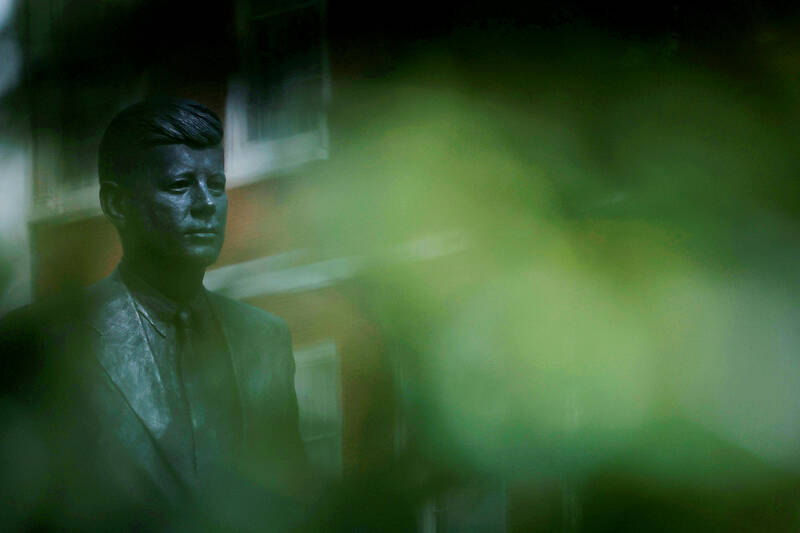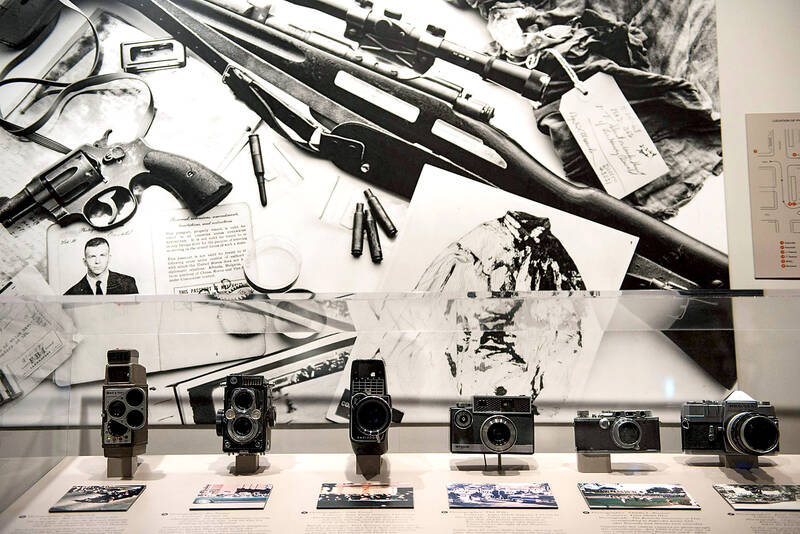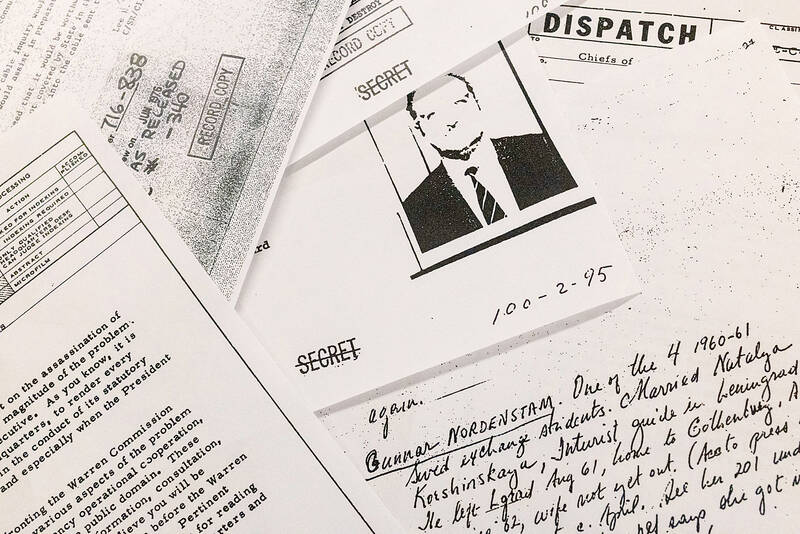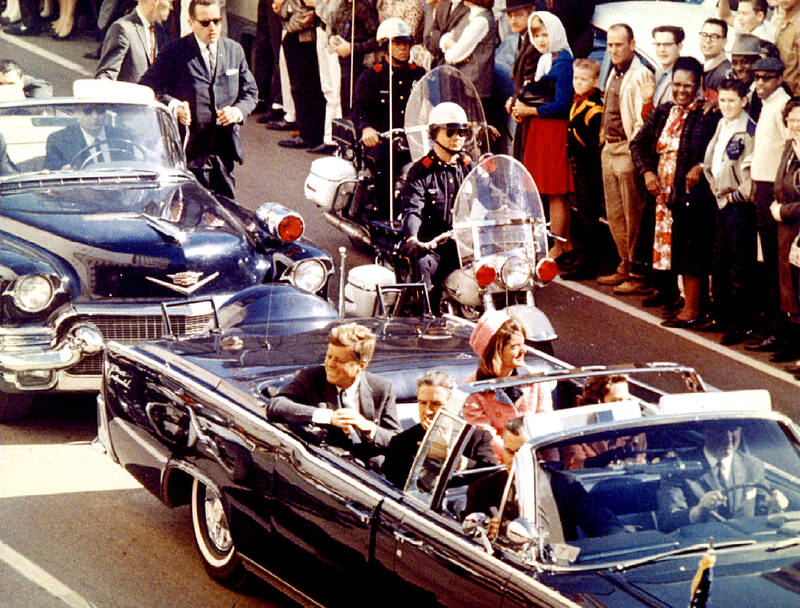More than 63,000 pages of records related to the 1963 assassination of President John F. Kennedy were released Tuesday following an order by US President Donald Trump, many without the redactions that had confounded historians for years and helped fuel conspiracy theories.
The US National Archives and Records Administration posted to its Web site roughly 2,200 files containing the documents. The vast majority of the National Archives’ collection of over 6 million pages of records, photographs, motion pictures, sound recordings and artifacts related to the assassination have previously been released.
Larry Sabato, director of the University of Virginia Center for Politics and author of The Kennedy Half-Century, said it will take time to fully review the records.

Photo: Reuters
“We have a lot of work to do for a long time to come, and people just have to accept that,” he said.
Trump announced the release Monday while visiting the John F. Kennedy Center for the Performing Arts in Washington, saying his administration would be releasing about 80,000 pages.
“We have a tremendous amount of paper. You’ve got a lot of reading,” Trump said.

Photo: AFP
Before Tuesday, researchers had estimated that 3,000 to 3,500 files were still unreleased, either wholly or partially. And just last month the FBI said it had discovered about 2,400 new records related to the assassination.
Jefferson Morley, vice president of the Mary Ferrell Foundation, a repository for files related to the assassination, said in a statement posted on the social platform X that the release is “an encouraging start.” He said much of the “rampant overclassification of trivial information has been eliminated” from the documents.
The National Archives said on its Web site that in accordance with the president’s directive, the release would encompass “all records previously withheld for classification.”

Photo: Reuters
But Morley said what was released Tuesday did not include two-thirds of the promised files, any of the recently discovered FBI files or 500 Internal Revenue Service records.
“Nonetheless, this is the most positive news on the release of JFK files since the 1990s,” Morley said.
Interest in details related to Kennedy’s assassination has been intense over the decades, with countless conspiracy theories spawned about multiple shooters and involvement by the Soviet Union and mafia.

Photo: Reuters
He was killed Nov. 22, 1963, on a visit to Dallas, when his motorcade was finishing its parade route downtown and shots rang out from the Texas School Book Depository building. Police arrested 24-year-old Lee Harvey Oswald, who had positioned himself from a sniper’s perch on the sixth floor. Two days later nightclub owner Jack Ruby fatally shot Oswald during a jail transfer.
A year after the assassination, the Warren Commission, which President Lyndon B. Johnson established to investigate, concluded that Oswald acted alone and that there was no evidence of a conspiracy. But that didn’t quell a web of alternative theories over the decades.
Oswald was a former Marine who defected to the Soviet Union before returning home to Texas.
Files in the new release included a memo from the CIA’s St. Petersburg station from November 1991 saying that earlier that month, a CIA official befriended a U.S. professor there who told the official about a friend who worked for the KGB. The memo said the KGB official had reviewed “five thick volumes” of files on Oswald and was “confident that Oswald was at no time an agent controlled by the KGB.”
The memo added that as Oswald was described in the files, the KGB official doubted “that anyone could control Oswald, but noted that the KGB watched him closely and constantly while he was in the USSR.” It also noted that the file reflected that Oswald was a poor shot when he tried target firing in the Soviet Union.
In the early 1990s, the federal government mandated that all assassination-related documents be housed in a single collection in the National Archives and Records Administration. The collection was required to be opened by 2017, barring any exemptions designated by the president.
Trump, who took office for his first term in 2017, had said that he would allow the release of all of the remaining records but ended up holding some back because of what he called the potential harm to national security. And while files continued to be released during President Joe Biden’s administration, some remained unseen.
Sabato said that his team has a “long, long list” of sensitive documents it is looking for that previously had large redactions.
“There must be something really, really sensitive for them to redact a paragraph or a page or multiple pages in a document like that,” he said. “Some of it’s about Cuba, some of it’s about what the CIA did or didn’t do relevant to Lee Harvey Oswald.”
Some of the previously released documents have offered details on the way intelligence services operated at the time, including CIA cables and memos discussing visits by Oswald to the Soviet and Cuban embassies during a trip to Mexico City just weeks before the assassination.

April 14 to April 20 In March 1947, Sising Katadrepan urged the government to drop the “high mountain people” (高山族) designation for Indigenous Taiwanese and refer to them as “Taiwan people” (台灣族). He considered the term derogatory, arguing that it made them sound like animals. The Taiwan Provincial Government agreed to stop using the term, stating that Indigenous Taiwanese suffered all sorts of discrimination and oppression under the Japanese and were forced to live in the mountains as outsiders to society. Now, under the new regime, they would be seen as equals, thus they should be henceforth

Last week, the the National Immigration Agency (NIA) told the legislature that more than 10,000 naturalized Taiwanese citizens from the People’s Republic of China (PRC) risked having their citizenship revoked if they failed to provide proof that they had renounced their Chinese household registration within the next three months. Renunciation is required under the Act Governing Relations Between the People of the Taiwan Area and the Mainland Area (臺灣地區與大陸地區人民關係條例), as amended in 2004, though it was only a legal requirement after 2000. Prior to that, it had been only an administrative requirement since the Nationality Act (國籍法) was established in

With over 80 works on display, this is Louise Bourgeois’ first solo show in Taiwan. Visitors are invited to traverse her world of love and hate, vengeance and acceptance, trauma and reconciliation. Dominating the entrance, the nine-foot-tall Crouching Spider (2003) greets visitors. The creature looms behind the glass facade, symbolic protector and gatekeeper to the intimate journey ahead. Bourgeois, best known for her giant spider sculptures, is one of the most influential artist of the twentieth century. Blending vulnerability and defiance through themes of sexuality, trauma and identity, her work reshaped the landscape of contemporary art with fearless honesty. “People are influenced by

The remains of this Japanese-era trail designed to protect the camphor industry make for a scenic day-hike, a fascinating overnight hike or a challenging multi-day adventure Maolin District (茂林) in Kaohsiung is well known for beautiful roadside scenery, waterfalls, the annual butterfly migration and indigenous culture. A lesser known but worthwhile destination here lies along the very top of the valley: the Liugui Security Path (六龜警備道). This relic of the Japanese era once isolated the Maolin valley from the outside world but now serves to draw tourists in. The path originally ran for about 50km, but not all of this trail is still easily walkable. The nicest section for a simple day hike is the heavily trafficked southern section above Maolin and Wanshan (萬山) villages. Remains of